Over the labour day long weekend, we made a visit to Vancouver Island to spend time with friends in Victoria, the Widdowsons. A trip to Juan De Fuca Provincial Park* was on the cards on one of the days there, and what a day it was! If there has been any moaning about how there hasn’t been much of a summer in the Pacific Northwest this year, this was a day to banish those memories. Clear skies, hot sun and a cool breeze. Quite perfect.
The drive from Victoria to Port Renfrew takes about two hours along scenic and winding roads. Botanical Beach, where we’re headed, is a part of the larger Juan De Fuca Provincial park. The Juan De Fuca strait separates Port Renfrew on Vancouver Island and Neah Bay on the NW corner of Washington State in the United States.
If you’re going to visit a marine park anywhere on Vancouver Island, you couldn’t do better than to have two people as familiar with the area as Tom and Ann Widdowson as your guides. Marine biologist Dr. Tom Widdowson is a leading expert in the study of algae and seaweeds. He’s spent decades studying the marine life here, often camping out on Botanical Beach in far less favourable conditions than this day threw at us. In fact, he mentioned that in all of his of many visits here over the years, he was hard pressed to recall another occasion when the sea was as glassy and calm as this. Lucky us!
It’s a cool, tree-lined hike down to the beach. The west coast lies open to powerful winds across the Pacific, and signs of their tremendous power are everywhere. The trees are gnarled and wind-sculpted and hang heavy with moss, fed by the moisture from the fog that regularly shrouds the area. The path is lined with thick shrubbery, including salal, which I sheepishly recognize from florist’s bouquets but never knew the name!
Tom recalls a time, many years before this area was a designated marine park, when there were no clearly marked trails. He was making his way down to the beach through trees and dense undergrowth. At one point when he happened to look down at his feet, he realized there were spots of light shining through what he had thought was the forest floor! He found himself retreating hastily from the cliff’s edge and, I’m guessing, giving thanks for the sturdy nature of that salal lattice!
The salal is loaded with purple-blue berries, from which Ann tells me her aunts used to make jelly. Visitors are strictly advised not to handle any of the plant and animal life here, so a taste of those berries is out of the question. For us anyway. Did I mention this is also cougar and bear country? A visiting card from a berry happy black bear lays smack in the middle of our path, halfway down to the beach. And it looks quite fresh too!
A Kilometre or so down the path, we arrive at the shore to a stunningly calm sea. The tide is coming in, deceptively gentle. The coarse sand of the beach, scattered with bleached driftwood, gives way to an undulating landscape of tide pools and rocks stained with algae, draped with seaweed or crusted with mussels and barnacles.
You have to tread carefully as you walk, taking care not to destroy the life clinging to the rocks, waiting for the tide to rise again. Tom points out some of the peculiar life forms that inhabit this stretch of shoreline as we wander over the rocks from one pool to another, the mid-day sun blazing down on the denizens of these little deeps.
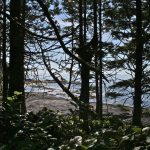

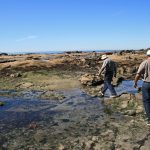
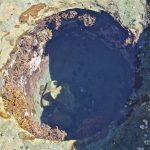
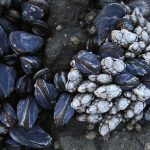
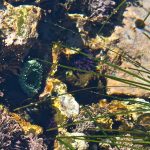
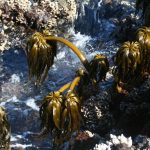
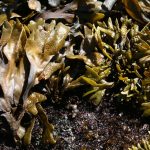
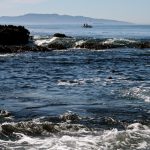
Tom identifies all the plants in common parlance for us – seagrass, or surfgrass, coral seaweed (Corallina vancouveriensis), sea cabbage, and sea lettuce. And, just when you’re thinking how much like a tasty hot-pot these pools look, some flabby “dead man’s fingers” pop into view. Watch out for those tousle headed sea palms perched along the edges of the rocks like some hippie chicks with a touch of the sun or something stronger – they grow where the waves hit the shore hardest! Green anemones (“carnivorous and always hungry” says Gordon Green) have ample opportunity to feed in the confines of these tide pools. Purple sea urchins nestle comfortably in indentations in the soft rock that they wear away with grinding teeth.Tom observes that one particular seaweed is not as plentiful in its usual location as it should be and goes in search of signs of growth elsewhere. We find a few small clumps. Whatever the reasons for the lack of growth, and there are probably many, it’s a reminder of how fragile this whole system is.
Blue California mussels, limpets, gooseneck barnacles – it’s all too easy to lose track of time in this fascinating world while that sneaky tide creeps in, slapping at the rocks at unexpected angles. The cold sea and powerful currents here are not to be trifled with, so we reluctantly retreat from the intertidal zone to the beach and our picnic lunch.
Tom and Ann tell us about the University of Minnesota research station that was established on this rocky coast, at the turn of the last century, by a remarkable woman named Josephine Tilden. Unfortunately, it didn’t survive long, but the fact that it existed at all is amazing. More about the saga can be found on the University of Minnesota’s Alumni website.
“The algae covering that exposed shore,” she wrote in a reminiscence years later, “were beyond my wildest dreams. I spent every daylight moment in collecting algae. At stated intervals my mother doled out warmed up beans and tea. At the end of the fourth day, Mr. Baird said to me, ‘I am going to give you a deed for the best four acres on my place. Take your choice.’ I chose, and that spot became the site of the Minnesota Seaside Station.”
That station was soon founded at the designated stretch of shore, now called Botanical Beach near Port Renfrew. Though it began as an extension of the taxonomic interests of Tilden and the University of Minnesota’s Department of Botany, the station quickly moved beyond its basic focus on the collection of algae and evolved into an educational center featuring a variety of studies, including geology, zoology, algology, and lichenology.
All that and a picnic lunch to digest as we drive home, discussing the seismic instability of areas of the Island as we pass “tsunami evacuation route” signs near Port Renfrew. It was a memorable trip and, back on the mainland, it’s still fresh in our minds a few days later when we feel the tremors from a magnitude 6.4 earthquake off the west coast of Vancouver Island!
* Juan De Fuca, the explorer, who, despite the very Spanish name, was a Greek! We were informed of this fact in no uncertain terms a day earlier while eating and drinking our way around the annual Greek festival in Victoria!

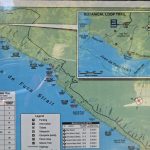
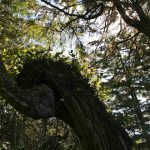
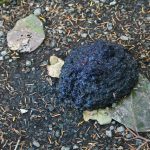
Hi Shalini,
I enjoyed your account of our trip to Botanical Beach very much. Thank you so much for all your kind words. We are looking forward to you and Chetan’s next trip to the Island. There is so much more over here to show you.
Ann
Hi Ann,
Thank you! We had the best time, and we look forward to visiting again. The Island is such an amazing place, we’d have to spend a lot more time there to begin to do it justice.
Very well written indeed!
Well, if you visit, you can see for yourself 😉
After my own heart! Great post.
This is such a wonderful post and I had to read it before I read “A Taste of Tofino”. That is a wealth of information you have provided and so many thanks to your friends and guides who took you around. Tidal Pools are a delight. We were told to look out for sea anemones at Anjuna , we were told that they would look like Gulab Jamuns ( the indian sweet) So me and the kids looked for hours and found not one . Such a chilling thought and we made our way out , as it is that beach is such a mess and a total horror. This post is such a delight to read as are all the others. Shalini your comment “You have to tread carefully as you walk, taking care not to destroy the life clinging to the rocks, waiting for the tide to rise again.” is such an eye opener. Not too many would think like this. Great Post and now I must toodle over to Tofino.
Thank you 🙂 That was such a memorable visit- a privilege to go with the Widdowsons, and quite the learning experience!